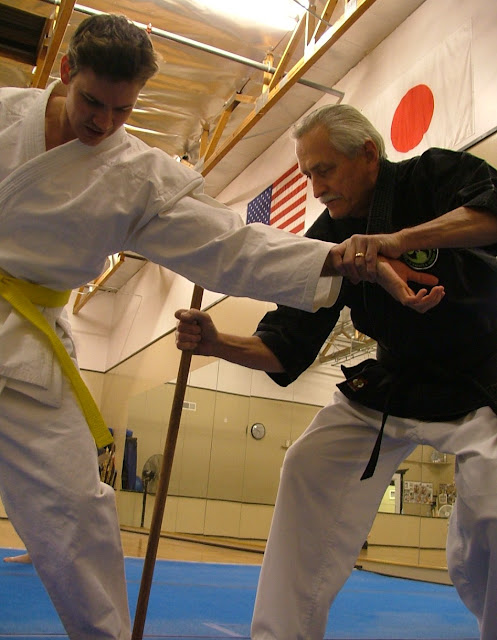“Do not think that I have come to bring peace to the earth. I have not come to bring peace, but a sword." - Matthew 10:34
 |
| Samurai arts |
(1) Samurai Sword (iaido & kenjutsu),
(2) Knife (tantojutsu),
(3) Fan (tessenjutsu)
(4) Spear (sojutsu)
(5) Polearm (naginata),
(6) Throwing Arts (jujutsu),
(7) Striking Arts (Kempojutsu),
(8) Restraining arts (hojojutsu)
(9) 6-foot pole (bojutsu), and offshoot arts such as the Half- (hanbojutsu) which includes similar arts like Walking cane (tsutekki), and even the short sticks (tebo and kuboton).
And then there are even more Samaria arts such as Japanese archery, guns, etc.
Prior to the pandemic, Hall of Famer Soke Hausel taught all of these arts to his students, but the worldwide invasion of our homelands closed the Hombu dojo in Mesa, and now Soke only teaches a few select students in a private dojo in Mesa.
The Japanese martial arts include many sub-martial arts, and each art has many, many aspects. These include:
Tantojutsu - the art of the knife!
Tantōjutsu (短刀術), the art of tantō (短刀), or short sword, approximately one shaku length, more commonly known as a knife in the West. The tantō, a blade often carried in a samurai's obi, or hidden from others for use in close quarters combat. And students also learn to use karambit, a Filipino curved blade used in knife fighting.
Historically, some Japanese women carried a variety of tantō (短刀術), known as kaiken for self-defense. The warrior women (onna-bugeisha), who were part of the samurai class, trained in tantojutsu and even were known to sleep with a knife under their pillow.
Historically, some Japanese women carried a variety of tantō (短刀術), known as kaiken for self-defense. The warrior women (onna-bugeisha), who were part of the samurai class, trained in tantojutsu and even were known to sleep with a knife under their pillow.
The traditional length of tanto is one shaku (11.93 inches), which included blade, handle, and hand-guard (tsuba). Some tanto varied from traditional size and became known as O-tanto or Sunobi tanto. The blade was typically single-edged, most were curved, and many had blood grooves and some elaborately decorated.
 |
| Kyle trains with Glenn at the Seiyo Hombu dojo in Mesa, Arizona. |
Tanto were classified as: (1) traditional tanto, which had a guard known as tsuba; (2) aikuchi tanto in which the tsuka and saya met without a tsuba, and (3) hamadashi tanto which had a small tsuba that barely protruded beyond the saya and tsuka, and was designed for comfort when carrying the weapon in the obi (belt).
Other styles of tanto differed by shape of blade. These include: (1) hira-zukuri - a flat, narrow and thick blade, used for slashing and piercing blows, (2) shobu-zukuri - a blade with a ridge line and blood groove, (3) moroha - a double edged tanto, (4) kissaki-moroha-zukuri - a long blade with sharp point (o-kissaki), and (5) kaikan - short tanto with small guards, usually carried by women.
When tanto was used on the battlefield it was designed to penetrate armor of other samurai. The tanto was usually carried in a wide cloth belt (obi) with the edge up and the handle turned to the right. In the home of the samurai, tanto was often placed with wakizashi (short sword).
 |
| Parts of the tanto |
 |
| Ben Corley demonstrates how to cut an attacker with his own knife at the University of Wyoming White Crane karate clinic |




.JPG)
+during+Utah-Arizona+clinic+in+Mesa+and+Gilbert.JPG)



.jpg)











